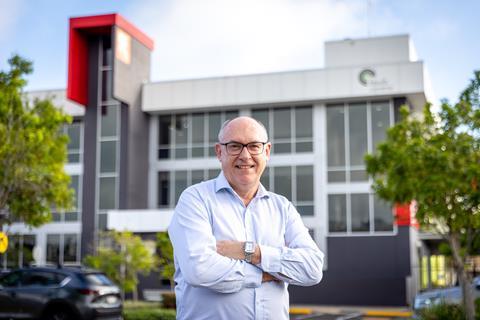Brisbane Markets and Brismark joint CEO, Andrew Young, shares his reflections on the site’s developments and what’s ahead for the Queensland central market
This August marks 60 years since the opening of Brisbane Markets at its current Rocklea location. The subsequent decades have shown more growth than was probably thought possible in 1964, and yet there’s still more on the horizon.

Brisbane Markets (BML) archives state that, “the modern, purpose-built market was a plan 30 years in the making following years of difficulties at the previous city location on Brisbane’s Roma Street.”
Around 2,000 guests attended the official opening of the Rocklea site in 1964 where the Queensland premier at the time, Frank Nicklin, said the market could be “classed as undoubtedly the best in Australia and among the best in the world”.
The Queensland government owned and operated the Brisbane Markets until 2002 when – after a two-year process – Queensland’s wholesaler representative, Brismark, led an industry-based consortium which won the competitive bid to acquire the site and associated operations.
“That was probably a defining point in relation to the life and history of the markets,” Andrew Young, BML and Brismark joint CEO tells Produce Plus.
Directly following the acquisition, BML implemented a series of plans to further enhance operations including purchasing additional land that became the site’s South Gate West Precinct.
Since then, there’s been a slew of buildings built and refurbished including approximately 25,000m2 of new warehouses in the last decade.
“Over the last 15 odd years, BML has spent about A$250m on site upgrading and redevelopment,” Young adds.
BML also became a cornerstone investor in Perth Markets following its privatisation in 2016 in a bid to support an industry-based ownership model, similar to how Brisbane operates.
“As a specialised central market owner, manager and developer, we saw industry involvement over there as reflecting the model here and our core business,” Young says.
It has since acquired 49 per cent of the available shares where it currently sits under standstill agreement.
“We are very comfortable with that level of ownership and the structure in place,” Young says. “We also keep in close discussions with our colleagues, like Fresh State, the wholesaler’s organisation in the Melbourne Markets, because at some point it’s likely that market will be privatised too and, if they want our support, the BML board would be willing to look at what it can do to support industry-based ownership in Melbourne as well.”
Flood mitigation
Following the devastating effects of Brisbane’s flood events in 2011 and 2022, BML has dedicated considerable efforts to upgrading the site for flood mitigation.
This has included the recent installation of elevated structures for electrical control panels and distribution boards across eight buildings completed in March and the development of a multi-level car park with stronger flooring and a higher ceiling to accommodate forklifts in the case of a flood.
“Right now, we’re finishing off a flood resilient warehousing facility that will accommodate all the critical spares in a flood resilient area,” says Young.
Upon completion, the building will feature a high-level loading dock for equipment receivals; secure, racked storerooms for critical spare parts and staff work areas on the upper level, above flood height. It will also be connected to the multi-level car park to allow access during flooding events.
“We’re also looking at a couple more flood mitigation projects potentially next year, including reconstructing a new bridge out the back, which provides for later exit from the site and earlier access post-flood,” adds Young.
New Price Report

Alongside planned construction works, Brismark is also preparing to launch a new price reporting app utilising data from Brismark’s Credit Service.
The mobile and web-based app, developed and funded by Brismark, is currently in its final testing phase and is expected to launch in September. It aims to provide the fresh produce industry clarity around pricing and trade across Queensland’s central market.
“Over the last 12 months, we’ve done a lot of work to finalise our specifications, get all the app development done and we’ve been testing since January this year,” says Young.
The app uses data derived from actual weekday trading transactions through Brismark’s Credit Service, which acts as the financial clearinghouse for the Brisbane Markets. This covers close to 80 per cent of Brismark’s wholesaler membership.
According to Young, the project comes in response to concerns raised by grower groups, the federal government, and the Australian Competition and Consumer Commission around the wholesale price transparency within the industry. The new report will address this issue within the Brisbane Markets.
“While the current reports have proven valuable in providing timely feedback on prices for many years, the lack of factually based verifiable market price information has resulted in criticism of the market wholesaling sector, which is what our wholesaler members have set out to address with the app,” he says.
“Current price reports available are based on discussion and observations. This new report is directly based on actual sales data. There’s nothing like that available.”
The app will have a range of subscription options, allowing users to view the daily pricing low, high and average as well as most sales for over 150 product lines. Depending on the subscription option, users will have access to up to six months of pricing data as well.
“Growers can look at that and see trend lines and the latest wholesale prices,” Young explains. “If they want to make decisions about what they’re harvesting, which market they’re sending them to, what they can budget on receiving or having an informed discussion with their wholesaler, it’s all there.”
Read the full version of this article and more in the latest edition of Produce Plus Magazine. You can subscribe to Produce Plus Magazine HERE.



